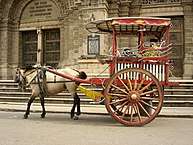Kalesa
A kalesa (also known as calesa, carromata, or caritela in Philippine Spanish) is a two-wheeled horse-drawn carriage used in the Philippines.[1] It is commonly vividly painted and decorated.[2] It was a primary mode of public and private transportation during the colonial era of the Philippines, though in modern times, they largely only survive as tourist attractions.
| Kalesa | |
|---|---|
_(1923).jpg) Top: A kalesa in Manila (c.1923); Bottom: A kalesa in Baywalk, Manila | |
| Application | Transportation |
| Powered | No |
| Self-propelled | No |
| Wheels | 2 |
History
Kalesa were first introduced to the Philippines in the 1700s by the Spanish. It became the major public and private form of transport in the Philippines up until the early 20th century.[1] It was also used to transport goods. They were manufactured by traditional workshops known as karoserya.[3]
Use of the kalesa declined after World War II, when mass public transportation was largely taken over by motorized jeepneys and tricycles. Kalesa in modern times are largely only used as tourist attractions. They are still preserved in some areas of the Philippines, such as in Vigan and Laoag.[4] Kalesas can also be found in Intramuros, where they cater to tourists and Binondo in Manila, as well as in Iligan, where decorated kalesas can be taken for a ride along a specific street. In Cagayan, kalesas are common, especially in Tuao, Tuguegarao, and other municipalities of the province.
The colorful decorations of the kalesa was also inherited by the post-World War II jeepney (which were also known as "auto calesa" in the 1940s). The legacy of the kalesa is also evident in the horse hood ornament of most jeepneys.[2]
Description
The kalesa looks like a two-wheeled inclined cart, and is drawn by a single horse. It is made from wood, metal, or a combination of both. Traditionally it had a single forward-facing bench that can accommodate two passengers. The kalesa driver commonly called as kutsero (Spanish cochero) sits on the driver's seat in front. Both the driver and the passengers are enclosed by a canopy originating from the back of the cab. Modern versions of the kalesa sometimes have two side-facing benches instead, similar to a jeepney, that can accommodate four to eight passengers.
Large four-wheeled versions of the kalesa were known as karwahe (Spanish carruaje); while drays drawn by carabao (usually used to transport cargo) were known as garetas or kareton (Spanish carretón).[3]
Kalesa had specific terminology for drivers. When a kutsero wants the horse to turn right, he says "mano” while he says "silla” to make the horse turn left.[5]
In popular culture
Composer Ambrosio Del Rosario composed the original music and National Artist of the Philippines Levi Celério wrote the lyrics for a song entitled Kalesa, in honour of the vehicle.[6]
An annual Kalesa Parade is held during the Binatbatan Festival of the Arts of Vigan City.[7]
Gallery
 A modern kalesa
A modern kalesa Kalesa parked in front of Vigan Cathedral
Kalesa parked in front of Vigan Cathedral- A modern kalesa in Intramuros
References
- Montefalcon, Moreen Ann M.; Cruz, Robin Lawrence I.; Inocencio, Marian Nicole J.; Portus, Alyssa Jean. "An Ergonomic Assessment of the Philippine Kalesa". In Goonetilleke, Ravindra S.; Karwowski, Waldemar (eds.). Advances in Physical Ergonomics & Human Factors. pp. 170–178. doi:10.1007/978-3-319-94484-5_18.
- Chiu, Imes (2008). The Evolution from Horse to Automobile: A Comparative International Study. Cambria Press. pp. 224–229. ISBN 9781604975468.
- "The Last Calesa Maker: How A Proud Fernandino Kept A Fading Industry Alive". Capital Town Pampanga. March 28, 2019. Retrieved March 26, 2020.
- Kalesa. Archived November 11, 2007, at the Wayback Machine Vigan City Philippines – Unesco World Heritage City.
- "Riding The Philippine 'Calesa' and Business". Archived from the original on November 28, 2010. Retrieved November 28, 2010.
- Kalesa – Video Watch, watch Youtube video, download Youtube video.
- Rivero, Imelda C. "Vigan's enduring 'kalesas' help keep the city's air clean". Philippine Information Agency. Retrieved March 26, 2020.